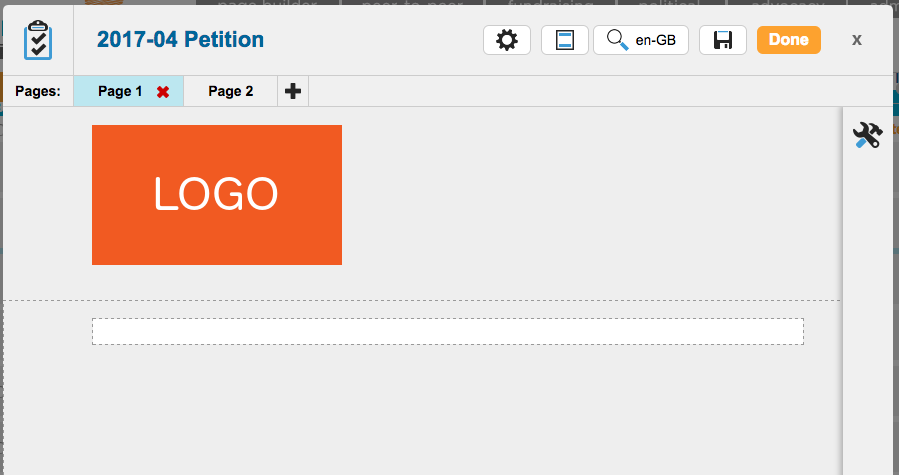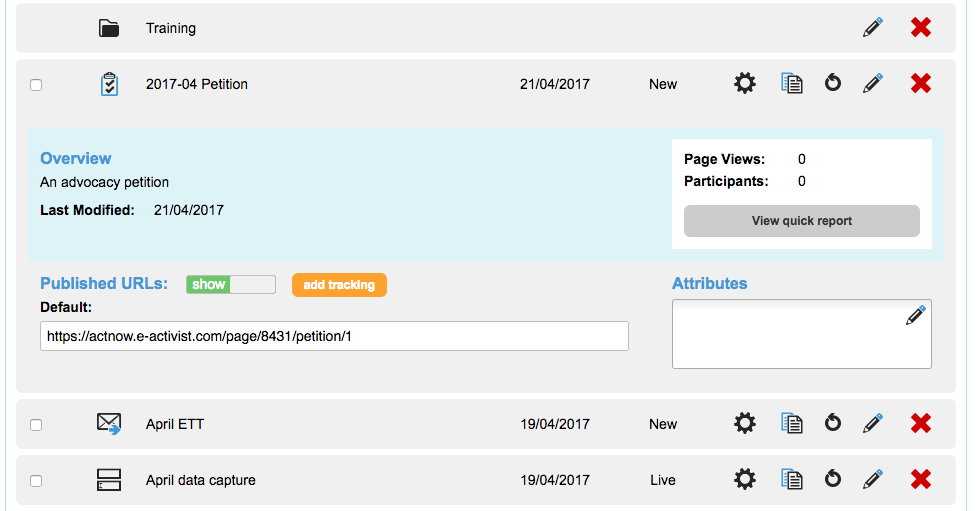Data capture step-by-step

A ‘data capture’ action is used when you want to collect information from your supporters, for example a survey.
They are different from petitions in that they are not used for campaigning purposes and so won’t be recorded in the advocacy reports. However the process of making them is exactly the same as petitions.
The supporters’ data is recorded so you use it to report on to communicate with them at a later date according to their responses. It is useful to be familiar with Questions which mean you can add any kind of bespoke input you like.
Summary of the steps
Here is a summary of the steps we’ll be going through, which you can also use as a reminder if you have created one before. Click Next at the bottom of this page to get a detailed explanation of each step.
Create your data capture page. Create from scratch or duplicate an existing page
Update your page settings. Determine what template to use
Add the content of your page. Add text, form fields, questions and buttons
Test and launch your campaign!
Create your data capture page
To create a new campaign, you can either duplicate a previous-made data capture page or create a new one from scratch.
To create a brand new page, click “New Page”. You will be shown a variety of different pages you can make:

Click on “Data Capture” and click Next. You will be taken to the settings page which you can read about on the next step.
Duplicating an existing campaign
Alternatively you can duplicate an existing page you have previously created. To do this, go to your list of campaigns (by clicking on Pages > Manage pages in the menu) and next to the one you wish to duplicate, click the copy icon under the “Dup” column. It will ask you for a new name (the box may further down the screen so you might need to scroll). Enter this and click Duplicate.
Click the cog icon in the toolbar and go to the next step.
Update the page settings

The following fields can be completed.
Name: This is the reference name of your page for your own purposes (the supporter won’t see this). It is a good idea to come up with a naming convention so you can keep track of your campaigns, which is especially useful when using the query builder. For example, “2017-09 Supporter survey”
Public title: This field is the public name of your page. You can reveal this by using page tags.
Status: By default, pages are “New” until you are ready to launch them. New means that the live URL is not available until you set the status to “Live”. You can also close pages here.
Base URL: The Base URL is the first part of the address of your page. By default this is https://ca.engagingnetworks.app or https://us.engagingnetworks.app, but you can read more here about where to set your default base URLs, and here for more about changing the Base URL to something more familiar to your supporters.
Notes: Any notes you want to add, type in here. This is for internal use and isn’t visible to supporters.
Closed landing page and Error landing page: read more here.
Address lookup: US Only – this allows you to validate addresses using postal code mapping. Only valid US address can submit the form.
Language: You can optionally add the ability to have different locales for your page, so that text blocks, forms and so on show different versions depending on the browser language.
Template: The template determines how your page looks – the header and footer, as well as fonts, colours and so on. For more about templates, click here.
Attributes: You can optionally catergorise your page according to Attributes.
Once you click next, you can optionally set notification settings which will can send you an email when a supporter completes the page. Click Save and the admin screen will close, showing you the page-builder itself.
Tip: If you want to update the information on this page later you can also access this screen whilst creating your page via the settings icon at the top of the page-builder editor.
Add the content of your page
Once you have completed your page’s settings, you will be taken to the page editor which allows you to add content such as text and form fields to your campaign.

This editor is “WYSIWYG”, and shows how your page will look once it is live, allowing you to edit the page by dragging in components, and hovering over them to edit them or move them around.
Pages
Note that initially you are on “Page 1”. You can have several pages allowing the supporter to step through the campaign step-by-step. You can navigate between pages using the “Page 1, Page 2” buttons at the top. A common set-up for data captures is:
Page 1
Two-column row
Left column – a Text block explaining what the data capture is about
Right column – a form for the supporter to add their name and perhaps also their address, including an opt-in question and button, along with any bespoke Questions
Page 2
One-column row
Text block saying thanks to the supporter
Social share buttons
However, you could spread your data capture over more pages if you wish. You can add new pages using the + button next to the pages:

When you add new pages, you have a choice of adding a standard page, or to link to another campaign (pre-populating any fields) or a redirection to your website:

Rows
Rows hold the content of your page, and can be one or two column. You can only drag components into “rows”, shown as a white box with a dotted border in the screenshot above. For more about rows, click here.
The toolbar
By hovering over the toolbar icon on the right, you have access to the types of content you can add. For more about the toolbar, click here.
Components
To add a design element to your page layout, click on the name of the tool to show which items are available. Once you have identified the item you’d like to add to your page, click and drag it into the layout. A common component is the “text block”, for example, which allows you to add formatted text to your page, and a “form block” that allows you to add form fields and questions, such as email address or an opt-in checkbox, as well as the submit button. For more about components, click here.
You may also want to include social sharing buttons, allowing the supporter to share your campaign by Facebook, Twitter or Google+.
Also consider whether you wish to add an automated thank you email – to do this, go to auto responders in the toolbar. More here.
Save, save, save…
Remember to continually Save your page as you add components and edit them. You can lose your amendments if you close your browser tab or the editor itself.
Test and launch your data capture!
Test your pages
Click the orange “Done” button to validate the page once you have saved the page and are ready to test it. This button reports on any missing elements, and reminds you about other things you may want to think about.
You can then view the page as if it were live by clicking the magnifying glass (Preview button). The page is shown in a new tab in “DEMO” mode (which you can confirm by viewing the URL – it will end with “?mode=DEMO”).
Note: If you have created versions for different locales or profiles, you will be able to view them via the preview button.
Make it live
Once you are happy it is working correctly, you can change the status from New to Live. To do this, click the cog icon to access the page Settings and change Status from New to Live, then click Save.
In the Page Builder list of pages, you can then click on the name of your page to view the live URL.

Under “Published URLs” you can see the URL of your page. Click “Add tracking” to add different versions of this URL for use on other channels, such as your website, in emails, or on Facebook. Then you can easily see how people come to see your page.
Once it has been running for a while, you can click “View quick report” to see how your action is doing, or look at the visual reporting for more details.
